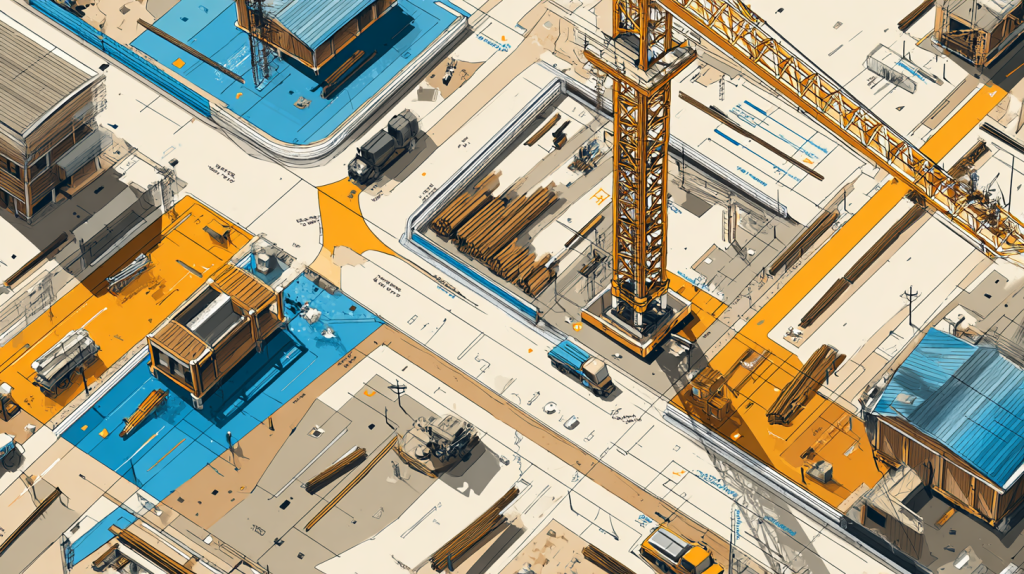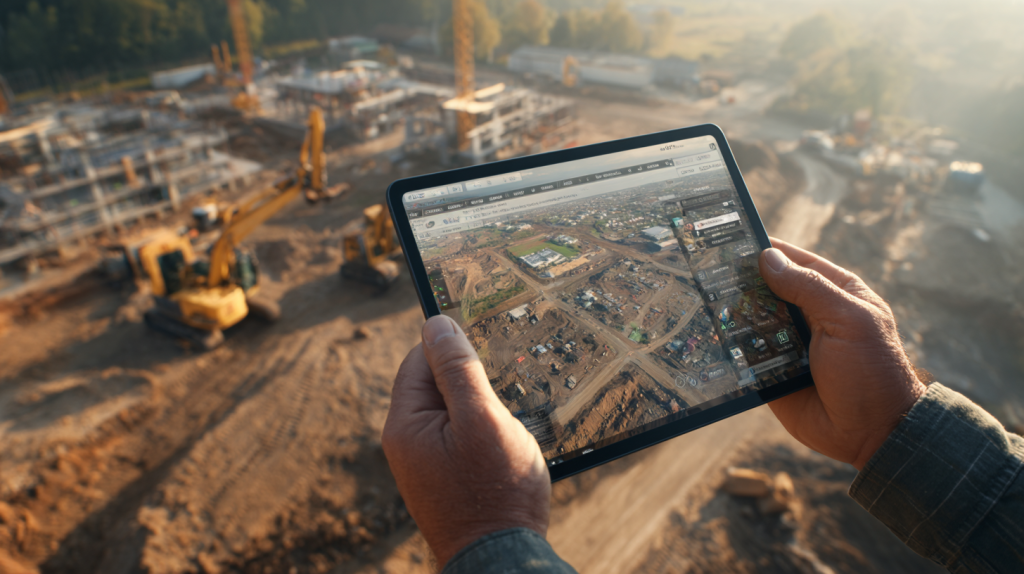Everything You Need to Know About Mapping Laydown Areas and Crane Routes in a Construction Site Utilization Plan (CSUP)
Table of Contents:

Why Are Laydown Areas and Crane Routes Critical to Site Planning?
On any large construction project, efficiency and safety depend heavily on how well the site is organized. Mapping laydown areas (where materials are stored and staged) and crane routes (the paths cranes take to move heavy loads) is one of the most critical parts of a Construction Site Utilization Plan (CSUP). Without thoughtful planning, even well-funded projects can experience bottlenecks, safety risks, and lost productivity.
Laydown areas serve as the logistical backbone of a site. They determine how easily crews can access materials, how deliveries are handled, and how much time is lost moving supplies from storage to installation points. Poorly placed laydown zones lead to cluttered jobsites, increased travel time, and more opportunities for accidents.
Crane routes are equally vital. Cranes are among the most expensive and potentially hazardous pieces of equipment onsite. Every movement must be planned in detail—accounting for load capacities, ground conditions, and overhead obstructions. Mapping routes ensures cranes can operate safely and efficiently without interfering with other trades or equipment.
Together, laydown and crane planning turn a chaotic jobsite into a well-choreographed operation where materials flow seamlessly and safety risks are minimized.
Top Benefits
- Improves jobsite organization and workflow efficiency.
- Minimizes safety risks by defining clear movement paths.
- Reduces idle time for crews and equipment.
Best Practices for Initial Site Planning
- Conduct early site surveys to identify constraints.
- Include logistics and safety teams in the layout design process.
- Reevaluate layouts regularly as site conditions evolve.
A well-mapped utilization plan keeps projects moving efficiently—saving time, reducing risk, and keeping everyone aligned.
What Factors Should Be Considered When Mapping Laydown Areas?
Laydown areas might seem simple—just open spaces for material storage—but their design and placement can make or break a project’s workflow. When mapping them in a site utilization plan, contractors must balance accessibility, safety, and logistics efficiency.
The first factor is proximity to work zones. Materials should be stored close enough to minimize transport time but far enough to avoid interfering with active construction. Large, bulky items like steel beams or precast panels need wide access points for delivery trucks and forklifts.
The second factor is ground conditions. Laydown zones must have stable, compacted surfaces capable of supporting heavy loads without rutting or flooding. Drainage, grading, and compaction tests are often required before storage begins.
Another key consideration is traffic flow. Laydown areas should not block emergency exits, crane swing paths, or primary travel routes. Segregating pedestrian and vehicle traffic improves safety and minimizes congestion.
Finally, logistics teams must plan for turnover and rotation. High-turnover materials like rebar or formwork should be placed in “quick-access” zones, while long-term storage items can be positioned farther away.
Top Benefits
- Streamlines material handling and reduces idle time.
- Ensures safe and stable storage for heavy or sensitive materials.
- Improves delivery efficiency and minimizes congestion.
Best Practices for Laydown Area Design
- Map access routes for both delivery and removal.
- Use signage and barriers to maintain order and safety.
- Regularly inspect and adjust zones as project needs change.
Strategic laydown area mapping transforms material handling from a logistical headache into a coordinated system that supports productivity and safety.

How Should Crane Routes Be Planned and Managed?
Crane route planning is one of the most technically demanding aspects of a site utilization plan. Because cranes handle heavy and oversized loads, their paths must be carefully mapped to ensure safe, efficient movement without collisions or downtime.
The first step is understanding crane type and capacity. Tower cranes, mobile cranes, and crawler cranes each have unique setup, reach, and mobility requirements. The layout should consider boom length, swing radius, and counterweight clearance to avoid conflicts with buildings, utilities, and scaffolding.
Next, ground bearing capacity must be verified. Cranes exert tremendous pressure on the soil, so geotechnical data should be used to confirm that ground conditions can support operations. Where necessary, contractors install crane mats or engineered pads to distribute loads.
Crane routes also require coordination with logistics and safety teams. Routes should be mapped to avoid high-traffic areas, power lines, and overhead structures. Warning signage and exclusion zones must be marked clearly. For mobile cranes, turning radii and access for transport vehicles must also be included.
Finally, routes should account for phasing. As the project progresses, cranes may need to relocate or adjust their swing paths. Keeping the plan dynamic ensures the site layout evolves with the construction sequence.
Top Benefits
- Ensures crane operations remain safe and compliant.
- Prevents collisions and interference with other trades.
- Reduces delays by optimizing load movement.
Best Practices for Crane Route Planning
- Verify soil stability and load capacity before setup.
- Keep crane swing zones clear of materials and personnel.
- Reassess routes regularly as structures rise or site conditions change.
Properly mapped crane routes create a safer, more efficient jobsite where heavy lifting operations run smoothly and predictably.
Related Articles:
Best Guide to AI in Construction Project Management: How Smart Tools Are Improving Construction Site Productivity; AI
Best Guide to Geographic Information Systems (GIS) in Construction: How Location-Based Data Improves Construction Project Management
Best Guide to Smart Helmets in Construction: Enhancing Safety, Communication, and Site Efficiency
Best Construction Scheduling Software for General Contractors and Superintendents
Best Guide to Solar Farm Construction Management: Top Solar Construction Management Software for Tracking Projects, Deliveries, and Compliance
Best Guide to Creating a Construction Site Utilization Plan with GIS Mapping, AI, and Logistics Tools

How Does GIS Technology Enhance Laydown and Crane Route Mapping?
Modern site planning has evolved beyond paper sketches and static CAD drawings. Geographic Information Systems (GIS) bring real-time data, visualization, and analytics into the planning of laydown areas and crane routes. By using GIS, project teams can see the site as a living, dynamic environment—one that changes daily with deliveries, excavations, and equipment movement.
GIS allows planners to overlay multiple data layers, including topography, soil conditions, drainage paths, existing utilities, and building footprints. This multi-dimensional view helps teams determine which areas can safely support heavy loads or equipment staging. It can also highlight restricted zones or environmental buffers that must remain clear.
When planning crane routes, GIS mapping provides measurable spatial accuracy. Teams can model crane swing radii, boom lengths, and clearance envelopes directly on the site map. By doing so, they can verify that planned paths won’t interfere with power lines, scaffolding, or other cranes. Integrating GIS with drone imagery further enhances accuracy, offering real-world visuals alongside digital models.
Another advantage is coordination. GIS allows stakeholders—engineers, logistics managers, and superintendents—to view and update maps collaboratively. Any field changes, such as moving a laydown zone or adjusting a crane route, are reflected instantly for all users.
Top Benefits
- Integrates terrain, infrastructure, and safety data into one map.
- Provides spatial accuracy for crane swing and travel modeling.
- Improves coordination through real-time, shared updates.
Best Practices for GIS-Enabled Site Planning
- Use drone and LiDAR data to validate GIS models.
- Integrate GIS updates into daily coordination meetings.
- Maintain a centralized platform for shared access across teams.
GIS ensures laydown and crane route mapping are not static tasks—but dynamic, data-driven strategies that evolve with the construction process.
What Common Mistakes Should Be Avoided When Designing Site Layouts?
Even with experience and planning, site layout errors can cause major inefficiencies or safety issues. The most common mistake is underestimating space requirements. Laydown areas that appear large on paper often become congested once materials arrive, especially when multiple trades share storage space. This can lead to double-handling of materials, increased equipment travel time, and reduced productivity.
Another frequent issue is poor traffic flow planning. When delivery trucks, forklifts, and cranes share the same access points, bottlenecks and safety risks increase. Traffic routes must be clearly defined and physically separated from pedestrian pathways wherever possible.
A third mistake is neglecting phasing. Construction sites evolve constantly, and a layout that works during early earthwork may become unworkable once vertical construction begins. Failing to plan for these transitions leads to disorganized material movement and unplanned relocations of cranes or storage zones.
Lastly, ignoring communication can derail even the best layouts. If crews aren’t informed of revised routes, access points, or laydown reassignments, confusion spreads quickly. Regular coordination and visual signage keep everyone aligned.
Top Benefits
- Helps teams anticipate and prevent workflow disruptions.
- Reduces rework caused by poor layout decisions.
- Improves site safety through proactive communication.
Best Practices for Avoiding Site Layout Mistakes
- Regularly review and adjust layouts as work progresses.
- Separate equipment, delivery, and pedestrian routes.
- Update maps and signage immediately when changes occur.
Avoiding these common pitfalls ensures that every square foot of the site is used efficiently, safely, and strategically.
How Do Laydown and Crane Route Plans Evolve Over a Project’s Lifecycle?
A Construction Site Utilization Plan isn’t static—it’s a living document that evolves with each project phase. Early in the project, when the site is mostly open, laydown areas and crane paths can be expansive. As foundations are poured and structures rise, those same areas must shrink, shift, or rotate to accommodate changing work zones.
During early construction, laydown zones focus on bulk materials like rebar, concrete forms, and aggregates. Crane paths are simple and wide. As the project moves into vertical work, cranes may need to relocate or operate in tighter spaces. Routes must be updated to reflect tower crane placements, swing paths, and building clearances.
By the final stages, laydown areas transition to finishing materials—smaller, high-value items that require weather protection and controlled access. The focus shifts from bulk handling to sequencing and delivery timing. Crane movements are minimized as more permanent structures limit their range.
Keeping the utilization plan updated throughout this evolution is critical. Digital platforms make this easier by allowing teams to edit maps in real time and track historical layout changes for future reference.
Top Benefits
- Adapts logistics and staging to each project phase.
- Improves coordination between trades as the site evolves.
- Reduces downtime caused by outdated layouts.
Best Practices for Dynamic Site Planning
- Review and update site utilization plans at least weekly.
- Involve field leaders when revising crane and laydown zones.
- Archive previous layouts for reference and audit purposes.
A living, adaptable site plan ensures the jobsite remains efficient from groundbreaking to project handover.

StruxHub
Experience the power of StruxHub today and witness firsthand how it can revolutionize your construction operations.
How StruxHub Simplifies Laydown and Crane Route Coordination
Managing laydown areas and crane routes manually can quickly become overwhelming—especially on large, multi-phase projects. StruxHub simplifies this process by bringing all logistics and site mapping data into one interactive platform.
Superintendents can use StruxHub to upload or integrate GIS maps, mark laydown zones, and update crane routes directly from the field. When materials are delivered or cranes are repositioned, the system automatically updates schedules and notifies relevant teams. This prevents conflicts, improves communication, and keeps everyone working from the same plan.
StruxHub also ties logistics to daily operations. Deliveries, inspections, and work tasks can be linked to specific laydown areas or equipment zones. This creates a clear record of how space and resources are used over time, supporting better planning and accountability.
Because StruxHub is cloud-based, changes made onsite are visible instantly to office teams and owners. Whether it’s a shift in crane swing zones or the relocation of material storage, decision-makers stay informed in real time.
Top Benefits
- Centralizes laydown and crane route data in one platform.
- Provides real-time visibility for both field and office teams.
- Prevents scheduling and routing conflicts automatically.
Best Practices for Using StruxHub in Site Layout Management
- Map all laydown and crane routes digitally within StruxHub.
- Link material deliveries and equipment schedules to mapped zones.
- Review and adjust layouts through weekly coordination meetings.
StruxHub transforms static site maps into actionable logistics tools, helping teams manage complexity, reduce downtime, and improve collaboration throughout construction.
StruxHub
Discover how StruxHub can revolutionize your construction management. Contact us today!
Unlock the Full Potential of Your Construction Projects with StruxHub
StruxHub enhances efficiency and coordination across all project phases, providing a single source of truth that eliminates silos and fosters collaboration. Real-time updates, financial management tools, and seamless commvunication features ensure that all team members and stakeholders are aligned and informed, reducing the risk of errors and delays. With comprehensive solutions for document management, risk mitigation, and quality control, StruxHub maintains project integrity and safety, while mobile access and integration capabilities further enhance project flexibility and efficiency.
StruxHub’s Key Features and Benefits:
- Advanced Delivery Management: Automate and optimize your delivery schedules, ensuring materials arrive just in time, every time.
- Site Communication: Utilize georeferenced maps and instant messaging to keep every team member informed and aligned.
- Construction Materials Management: Track inventory levels and manage materials procurement with ease, reducing waste and avoiding project delays.
- Construction Safety & Inspection Workflows: Implement customizable mobile forms for conducting safety inspections and managing compliance documentation effortlessly.
- Short-Term Scheduling: Visualize project tasks with detailed floor plans, linking each activity to specific locations for better planning accuracy.
- Construction Resource Management: Efficiently allocate personnel and equipment, maximizing productivity and reducing idle time.
StruxHub’s Product Offering:
- StruxHub Deliveries: Simplifies the coordination of incoming deliveries, ensuring materials and equipment are precisely timed to project needs.
- StruxHub Logistics: Offers intelligent site logistics planning, from crane scheduling to space allocation, for smoother operations.
- StruxHub Safety: Elevates on-site safety standards with easy-to-use tools for inspections, permits, and incident reporting.
- StruxHub Scheduling: Enhances project timelines with intuitive scheduling tools that ensure tasks are completed efficiently and on time.
With StruxHub, construction companies can look forward to a streamlined, more efficient project execution that delivers on time and within budget. Embrace the power of innovation and take your construction projects to the next level.
Don’t miss out on the opportunity to optimize your construction management processes with StruxHub. Sign up for a free demo today. Let’s build smarter, together.

FAQ
What is the purpose of mapping laydown areas and crane routes in a site utilization plan?
The main purpose of mapping laydown areas and crane routes is to create a safer, more organized, and efficient construction site. These maps serve as visual roadmaps for how materials, equipment, and people move throughout the project. Without proper planning, sites can quickly become congested, disorganized, and hazardous—leading to costly delays and safety incidents.
Laydown areas determine where materials are received, stored, and staged before installation. Properly mapped zones reduce travel time, minimize double handling, and help maintain site cleanliness. Crane routes, on the other hand, define how cranes and heavy equipment operate safely within the site’s boundaries. A well-designed route considers boom swing radii, ground bearing capacities, and clearances for overhead structures or utilities.
Together, these plans ensure that deliveries, lifting operations, and material handling occur without interfering with other site activities. They also support safety compliance by establishing exclusion zones and traffic segregation between workers, trucks, and equipment.
In addition, these maps help communicate logistics strategies to all stakeholders—from field crews to subcontractors and inspectors. Everyone works from a shared visual reference, improving coordination and reducing confusion.
Ultimately, mapping laydown and crane routes is about transforming site logistics from chaos into choreography—keeping the project safe, productive, and predictable.
How often should laydown and crane route maps be updated during construction?
Laydown and crane route maps should be treated as living documents that evolve throughout the project. Ideally, updates occur weekly or whenever a significant site condition changes—such as a new structure being erected, utilities being installed, or crane equipment being relocated.
Construction sites are dynamic environments. What works in the excavation phase won’t necessarily work during structural steel erection or interior finishes. As the project progresses vertically, available ground space shrinks, requiring constant reallocation of laydown zones. Crane paths also shift as work areas expand or new obstacles appear.
Frequent updates prevent outdated maps from causing logistical confusion or safety hazards. Many contractors use digital platforms like StruxHub or GIS-based tools that allow field teams to update layouts in real time. These systems make revisions accessible instantly to all project participants, eliminating the risk of crews working from old plans.
Weekly coordination meetings are an excellent time to review the latest site layout. Logistics managers, superintendents, and crane operators can discuss any upcoming changes and verify that everyone understands the new routes and zones.
Regularly refreshing these maps keeps logistics efficient and ensures crews always have clear guidance. Consistent updates are not just best practice—they are essential for maintaining safety and productivity on large, evolving jobsites.
What are the biggest safety risks when planning crane routes and laydown zones?
The biggest safety risks arise from poor planning, miscommunication, and lack of visibility. On the crane side, the most common hazards include overhead collisions, tip-overs, and ground instability. If crane swing paths are not properly mapped, they can intersect with buildings, scaffolding, or power lines. Failing to verify ground bearing capacity may lead to catastrophic equipment failure, especially when lifting heavy loads.
In laydown zones, the main risks involve material stacking, congestion, and restricted access. Improperly stored materials can collapse or obstruct pathways. Without clear segregation, delivery trucks may interfere with pedestrian traffic, increasing the likelihood of struck-by incidents.
Safety risks also increase when plans are not updated as site conditions evolve. A crane operating on an outdated route or a crew delivering materials to a relocated laydown area can create dangerous conflicts.
To mitigate these risks, every route and laydown zone should be physically marked and communicated through site signage. Daily toolbox talks should review critical lifting operations, exclusion zones, and emergency procedures. Integrating GIS or StruxHub’s mapping tools further enhances visibility, allowing safety officers to monitor compliance in real time.
When safety is built into logistics planning from the start, the risk of incidents drops dramatically—and the entire site operates more efficiently.
How does GIS improve accuracy in laydown and crane planning?
GIS improves accuracy by providing spatial intelligence—a way to analyze the physical environment using precise geographic data. Traditional 2D drawings can’t capture elevation, terrain, or real-time site conditions as effectively as GIS. By layering topographic data, soil capacity maps, and existing utilities onto a single platform, planners can identify the best and safest locations for storage and crane operations.
GIS also integrates data from drones, LiDAR scans, and GPS sensors to create a digital twin of the construction site. This gives planners the ability to simulate crane movements, verify clearances, and test multiple layout scenarios before implementing them in the field. It significantly reduces trial-and-error adjustments and improves accuracy in identifying load-bearing areas.
Another major advantage is dynamic updating. As conditions change—such as excavation progress or new building structures—GIS allows instant updates to the plan. These updates are accessible to field teams in real time, ensuring everyone works from the most current information.
In short, GIS brings science and precision into site utilization planning. It combines measurement accuracy with real-world visualization, making crane and laydown mapping far more reliable, data-driven, and safe.
How does StruxHub help teams manage and update laydown and crane route mapping?
StruxHub takes the complexity out of mapping by providing a centralized, cloud-based platform where all site layout data—laydown areas, crane routes, and delivery zones—can be viewed and updated in real time.
For field teams, this means no more outdated PDFs or confusion about which map version is correct. Superintendents can update site layouts directly from mobile devices while walking the jobsite. When a laydown zone moves or a crane route changes, StruxHub automatically notifies relevant trades, drivers, and safety personnel.
For logistics managers, StruxHub provides a clear visual dashboard showing where materials, cranes, and equipment are located at any given time. This reduces scheduling conflicts and helps optimize space usage. The platform can also link specific deliveries or work tasks to mapped zones, ensuring materials flow smoothly from gate to installation.
Owners and project managers benefit from transparency. They can log in anytime to view real-time site layouts and understand how logistics affect schedule performance.
Ultimately, StruxHub transforms site utilization from a static plan into a living, interactive system—helping teams manage movement, safety, and efficiency across the entire jobsite with clarity and control.

StruxHub
Discover how StruxHub can revolutionize your construction management. Contact us today!
Pillar Articles Links:
Best Guide to Construction Logistics Plans (CLPs): What Owners Want to See Before Work Starts
Best Construction Scheduling Software for General Contractors and Superintendents



